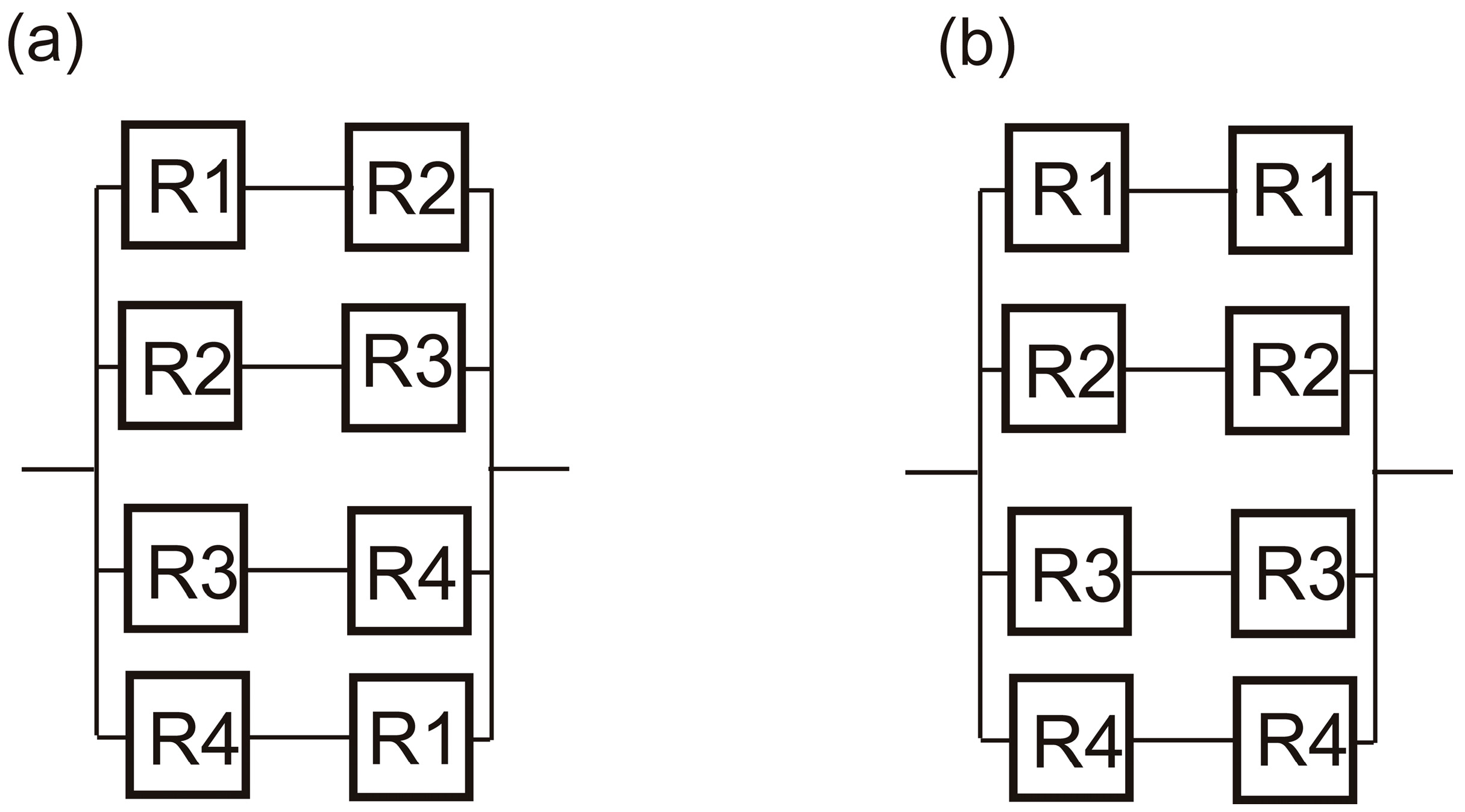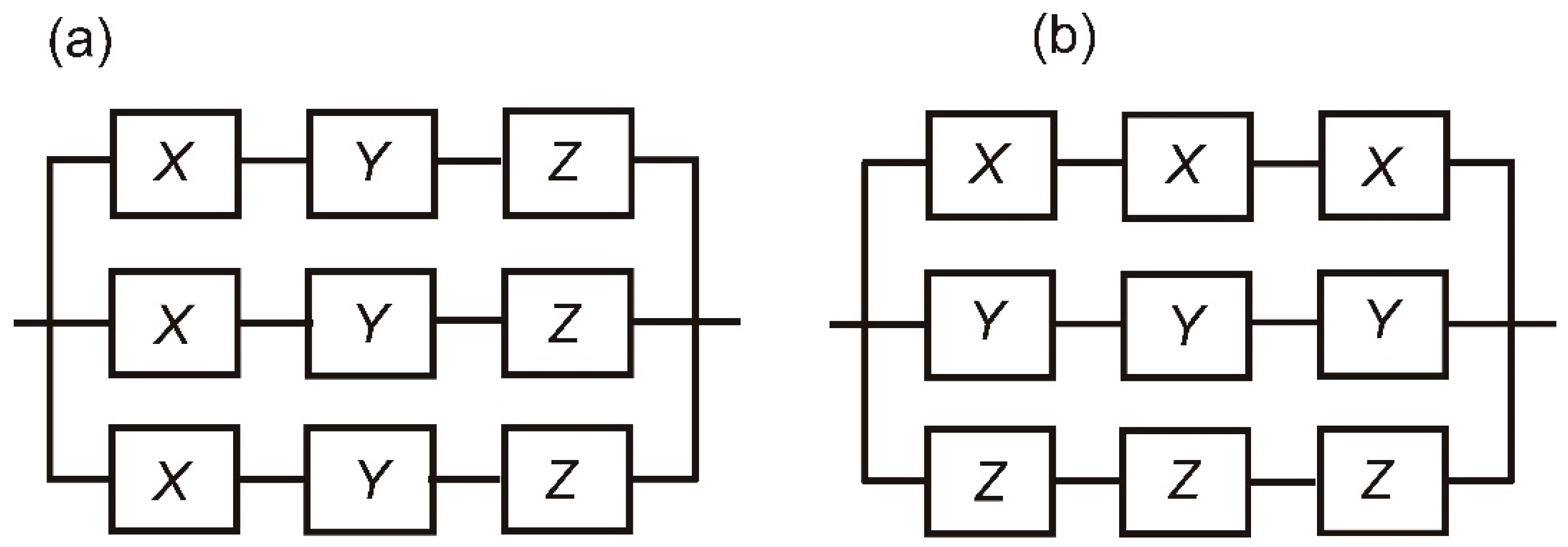Improving the Reliability of Parallel and Series–Parallel Systems by Reverse Engineering of Algebraic Inequalities
Abstract
1. Introduction
- The proposal and proof of a new general algebraic inequality, applicable to enhancing the reliability of parallel and series–parallel systems.
- The development of a method to improve the reliability of parallel and series–parallel systems through the reverse engineering of complex algebraic inequalities—without requiring any information about the reliability of individual components.
- The establishment of a foundational result: for parallel systems, a symmetric arrangement of interchangeable components across parallel branches consistently yields higher reliability than an asymmetric arrangement, regardless of the components’ individual reliabilities or their rankings.
- The establishment of another foundational result: for series–parallel systems, an asymmetric arrangement of interchangeable redundant components consistently yields higher reliability than a symmetric arrangement, regardless of the components’ individual reliabilities or their rankings.
2. Improving System Reliability of Parallel Systems Through Symmetric Arrangement of Components
Application Examples Related to Improving Reliability of Parallel Systems
3. Parallel Systems with Multiple Components in Each Branch
4. A General Inequality
5. Alternative Interpretation of Inequality (1)
6. Conclusions
6.1. Summary of Findings
- -
- The reliability of parallel and series–parallel systems can be enhanced without the need to know the reliabilities of individual components.
- -
- A new general algebraic inequality related to the reliability of parallel and series-parallel systems has been proposed and proved for the first time.
- -
- A novel, algorithmic proof technique has been developed to establish the proposed general inequality
- -
- Through the reverse engineering of the new general inequality, it was discovered that symmetric arrangements of identical, interchangeable components in parallel systems result in higher reliability compared with asymmetric configurations.
- -
- For series–parallel systems, asymmetric arrangements of interchangeable redundancies lead to greater system reliability than symmetric ones.
6.2. Significance of Results
6.3. Limitations of This Study
6.4. Suggestions for Future Research
Funding
Data Availability Statement
Conflicts of Interest
Appendix A
References
- Hoyland, A.; Rausand, M. System Reliability Theory; John Wiley & Sons, Inc.: New York, NY, USA, 1994. [Google Scholar]
- Billinton, R.; Allan, R.N. Reliability Evaluation of Engineering Systems, 3rd ed.; Plenum Press: New York, NY, USA, 1992. [Google Scholar]
- Ramakumar, R. Engineering Reliability, Fundamentals and Applications; Prentice Hall: Upper Saddle River, NJ, USA, 1993. [Google Scholar]
- Lewis, E.E. Introduction to Reliability Engineering, 2nd ed.; John Wiley & Sons: New York, NY, USA, 1996. [Google Scholar]
- Ebeling, C.E. Reliability and Maintainability Engineering; McGraw-Hill: Boston, MA, USA, 1997. [Google Scholar]
- O’Connor, P.D.T. Practical Reliability Engineering, 4th ed.; John Wiley & Sons: New York, NY, USA, 2002. [Google Scholar]
- Modarres, M.; Kaminskiy, M.P.; Krivtsov, V. Reliability Engineering and Risk Analysis, a Practical Guide, 3rd ed.; CRC Press: Boca Raton, FL, USA, 2017. [Google Scholar]
- Dhillon, B.S. Engineering Systems Reliability, Safety, and Maintenance; CRC Press: Boca Raton, FL, USA, 2017. [Google Scholar]
- Ram, M. (Ed.) Reliability Engineering Methods and Applications; CRC Press: Boca Raton, FL, USA, 2021. [Google Scholar]
- Garg, H.; Ram, M. Engineering Reliability and Risk Assessment; Elsevier: Amsterdam, The Netherlands, 2022. [Google Scholar]
- Sun, Y.; Li, L.; Tiniakov, D. Reliability Engineering; Springer: Singapore, 2024. [Google Scholar]
- Ding, Y.; Hu, Y.; Li, D. Redundancy Optimization for Multi-Performance Multi-State Series-Parallel Systems Considering Reliability Requirements. Reliab. Eng. Syst. Saf. 2021, 215, 107873. [Google Scholar] [CrossRef]
- Aqel, I.; Mohamed Mellal, M. Optimal reliability allocation of heterogeneous components in pharmaceutical production plant. Int. J. Interact. Des. Manuf. 2023, 17, 1711–1720. [Google Scholar] [CrossRef]
- Florin, L.; Petru, C.; Costin, B. Optimization Methods for Redundancy Allocation in Large Systems. Vietnam J. Comput. Sci. 2020, 7, 1–19. [Google Scholar]
- Si, S.; Zhao, J.; Cai, Z.; Dui, H. Recent advances in system reliability optimization driven by importance measures. Front. Eng. Manag. 2020, 7, 335–358. [Google Scholar] [CrossRef]
- Fink, A.M. An essay on the history of inequalities. J. Math. Anal. Appl. 2000, 249, 118–134. [Google Scholar] [CrossRef]
- Hardy, G.; Littlewood, J.E.; Pólya, G. Inequalities; Cambridge Univ. Press: Cambridge, UK, 1999. [Google Scholar]
- Steele, J.M. The Cauchy-Schwarz Master Class: An Introduction to the Art of Mathematical Inequalities; Cambridge Univ. Press: Cambridge, UK, 2004. [Google Scholar]
- Sedrakyan, H.; Sedrakyan, N. Algebraic Inequalities; Springer: New York, NY, USA, 2010. [Google Scholar]
- Cloud, M.J.; Drachman, B.C.; Lebedev, L.P. Inequalities: With Applications in Engineering, 2nd ed.; Springer: Berlin/Heidelberg, Germany, 2014. [Google Scholar]
- Berg, V.D.; Kesten, H. Inequalities with applications to percolation and reliability. J. Appl. Probab. 1985, 22, 556–569. [Google Scholar] [CrossRef]
- Corley, H.W.; Dwobeng, E.O. Relating Optimization Problems to Systems of Inequalities and Equalities. Am. J. Oper. Res. 2020, 10, 284–298. [Google Scholar] [CrossRef]
- Dohmen, K. Improved Inclusion-Exclusion Identities and Bonferroni Inequalities with Reliability Applications. SIAM J. Discret. Math. 2006, 16, 156–171. [Google Scholar] [CrossRef]
- Hill, S.D.; Spall, J.C.; Maranzano, C.J. Inequality-based reliability estimates for complex systems. Nav. Res. Logist. 2013, 60, 367–374. [Google Scholar] [CrossRef]
- Kundu, C.; Ghosh, A. Inequalities involving expectations of selected functions in reliability theory to characterize distributions. Commun. Stat.-Theory Methods 2017, 46, 8468–8478. [Google Scholar] [CrossRef][Green Version]
- Liu, S.; Lin, S. Robust adaptive controller design for uncertain fuzzy systems using linear matrix inequality approach. Int. J. Model. Identif. Control 2013, 18, 110. [Google Scholar] [CrossRef]
- Makri, F.; Psillakis, Z. Bounds for reliability of k-within two-dimensional consecutive-r-out-of-n failure systems. Microelectron. Reliab. 1996, 36, 341–345. [Google Scholar] [CrossRef]
- Marshall, A.W.; Olkin, I.; Arnold, B.C. Inequalities: Theory of Majorization and Its Applications, 2nd ed.; Springer: New York, NY, USA, 2010. [Google Scholar]
- Navarro, J.; Del Águila, Y.; Sordo, M.A.; Suárez-Llorens, A. Preservation of stochastic orders under the formation of generalized distorted distributions. Applications to coherent systems. Methodol. Comput. Appl. Probab. 2016, 18, 529–545. [Google Scholar] [CrossRef]
- Rastegin, A. Convexity inequalities for estimating generalized conditional entropies from below. Kybernetika 2012, 48, 242–253. [Google Scholar]
- Rosenbaum, R.A. Sub-additive functions. Duke Math. J. 1950, 17, 227–247. [Google Scholar] [CrossRef]
- Todinov, M.T. Reverse Engineering of Algebraic Inequalities: Exploring New Physical Realities and Optimising Products and Processes; CRC Press: Boca Raton, FL, USA, 2025. [Google Scholar]












| r1 | r2 | r3 | r4 | Fa | Fb |
|---|---|---|---|---|---|
| 0.61 | 0.92 | 0.75 | 0.45 | 0.065 | 0.034 |
| 0.2 | 0.6 | 0.1 | 0.7 | 0.662 | 0.31 |
| 0.8 | 0.4 | 0.65 | 0.22 | 0.355 | 0.166 |
| 0.1 | 0.75 | 0.65 | 0.12 | 0.432 | 0.246 |
| 0.85 | 0.55 | 0.88 | 0.46 | 0.0996 | 0.0344 |
| 0.5 | 0.7 | 0.25 | 0.7 | 0.288 | 0.183 |
| 0.35 | 0.48 | 0.70 | 0.14 | 0.474 | 0.338 |
| 0.1 | 0.2 | 0.15 | 0.7 | 0.791 | 0.474 |
| 0.89 | 0.99 | 0.79 | 0.95 | 9.987 × 10−4 | 1.51 × 10−4 |
| r1 | r2 | Fa | Fb |
|---|---|---|---|
| 0.16 | 0.85 | 0.75 | 0.27 |
| 0.76 | 0.4 | 0.48 | 0.35 |
| 0.9 | 0.2 | 0.67 | 0.18 |
| 0.85 | 0.32 | 0.53 | 0.24 |
| 0.09 | 0.7 | 0.88 | 0.5 |
| 0.1 | 0.7 | 0.865 | 0.505 |
| 0.98 | 0.94 | 6.21 × 10−3 | 4.61 × 10−3 |
| f1 | f2 | f3 | f4 | Ra | Rb |
|---|---|---|---|---|---|
| 0.7 | 0.3 | 0.87 | 0.43 | 0.092 | 0.255 |
| 0.32 | 0.56 | 0.45 | 0.68 | 0.264 | 0.333 |
| 0.88 | 0.20 | 0.40 | 0.91 | 0.031 | 0.131 |
| 0.21 | 0.35 | 0.12 | 0.54 | 0.585 | 0.830 |
| 0.56 | 0.23 | 0.78 | 0.39 | 0.216 | 0.389 |
| 0.75 | 0.42 | 0.45 | 0.88 | 0.0648 | 0.114 |
| 0.1 | 0.7 | 0.25 | 0.19 | 0.456 | 0.716 |
| 0.98 | 0.89 | 0.82 | 0.91 | 4.63 × 10−4 | 9.48 × 10−4 |
Disclaimer/Publisher’s Note: The statements, opinions and data contained in all publications are solely those of the individual author(s) and contributor(s) and not of MDPI and/or the editor(s). MDPI and/or the editor(s) disclaim responsibility for any injury to people or property resulting from any ideas, methods, instructions or products referred to in the content. |
© 2025 by the author. Licensee MDPI, Basel, Switzerland. This article is an open access article distributed under the terms and conditions of the Creative Commons Attribution (CC BY) license (https://creativecommons.org/licenses/by/4.0/).
Share and Cite
Todinov, M. Improving the Reliability of Parallel and Series–Parallel Systems by Reverse Engineering of Algebraic Inequalities. Mathematics 2025, 13, 1381. https://doi.org/10.3390/math13091381
Todinov M. Improving the Reliability of Parallel and Series–Parallel Systems by Reverse Engineering of Algebraic Inequalities. Mathematics. 2025; 13(9):1381. https://doi.org/10.3390/math13091381
Chicago/Turabian StyleTodinov, Michael. 2025. "Improving the Reliability of Parallel and Series–Parallel Systems by Reverse Engineering of Algebraic Inequalities" Mathematics 13, no. 9: 1381. https://doi.org/10.3390/math13091381
APA StyleTodinov, M. (2025). Improving the Reliability of Parallel and Series–Parallel Systems by Reverse Engineering of Algebraic Inequalities. Mathematics, 13(9), 1381. https://doi.org/10.3390/math13091381





